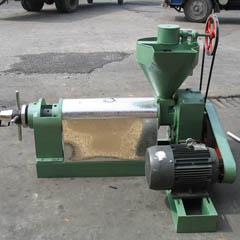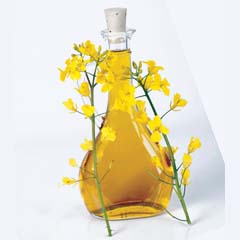
Rapeseed Oil Press
Rapeseed (Brassica napus), also known as rape, oilseed rape, rapa, rapaseed and (in the case of one
particular group of cultivars) canola, is a bright yellow flowering member of the family Brassicaceae
(mustard or cabbage family).
Natural rapeseed oil contains 50% erucic acid. Wild type seeds also contain high levels of
glucosinolates (mustard oil glucosindes), chemical compounds that significantly lowered the
nutritional value of rape seed press cakes for animal feed. Canola, originally a syncopated form of the
abbreviation "Can.O., L-A." (Canadian Oilseed, Low-Acid) that was used by the Manitoba government
to label the seed during its experimental stages, is now a tradename for 'double low' (low erucic acid
and low glucosinolate) rapeseed. Sometimes the "Canola-quality" label is affixed to other varieties as
well.
Processing of rapeseed for oil production provides rapeseed animal meal as a by-product. The by-
product is a high-protein animal feed, competitive with soya[citation needed]. The feed is mostly
employed for cattle feeding, but also for pigs and chickens (though less valuable for these). The meal
has a very low content of the glucosinolates responsible for metabolism disruption in cattle and pigs
[citation needed]. Rapeseed "oil cake" is also used as a fertilizer in China, and may be used for
ornamentals, such as Bonsai, as well.
Production Method of Rapeseed Oil Production:
1. Cleaning: cleaning before the first rapeseed on the bamboo baskets, the broken foot which together
with the mud (mud), and then filtered. Removed through the windmill lighter than rapeseed gray
debris. Thickness were then sieve to remove greater than or less than the rapeseed inclusions.
2. Broiling: Using sandwich pot (two pots can also be set up and use), mezzanine, or fine sand can be
filled Cao Hui. Start fried, the fire may be slightly larger, about 0.5 hours later, a burst of rapeseed pot,
which should control the fire. Rapeseed pan 10 minutes before the flame should be suppressed, when
the pot temperature reached rapeseed 115 ~ 120 ℃, after hand-twist rapeseed crushed golden brown,
you can pan. Qin flip when fried.
3. Grinding: grinding to be flat, adjusting the level of good friction, even under the material, size, seeds
separate grinding, grinding, when not the whole seed. Grind seeds should wash turned ground sweep,
the first Road will play a slot blank, adding about 3% of the screen, or 2% of the net Mallotus 3-
centimeter-long mixed-grass heart, the pressure out of billet thickness more than 0.2 centimeters,
mixed Mallotus or grass under the heart, allows the direct steam blanks.
4. Steamed blank: Head and Body steam 2 minutes or so, take the green gas, two blank steam 25
minutes. Continuously to the pot when steaming water to supplement the loss. Steam waist not leak,
light a fire of coal to increase uniformity. Caldron at the end, we should add a layer of brown and
protecting caldron at the end, but also non-stick blanks. At this point the water should be Qinhuan
steamer.
5. Packet cake, on the pressing: Head Road, playing double-ring, two dozen laps, distributed packet
cake, centralized installation pressing, package cake to be fast, the cake has to be tight foot flat foot.
Package cake with scattered grass is better.
6. Crush: tap, ground fight. Make cake quickly pressed out of oil soft reduction, handling pressure, 1
hour, oil and most of the squeeze, re-play, slow play, to increase the pressure. Yao Da-ping hit is hit
pole up and down sharp uniform. Road to play the first three hours, the oil 90%, two dozen 4 hours,
squeeze out the next morning. In order to prevent the cold wind, covered with insulation board or sacks
squeezed.
Biodiesel Use of Rapeseed Oil
Rapeseed oil is used in the manufacture of biodiesel for powering motor vehicles. Biodiesel may be
used in pure form in newer engines without engine damage, and is frequently combined with fossil-fuel
diesel in ratios varying from 2% to 20% biodiesel. Formerly, owing to the costs of growing, crushing,
and refining rapeseed biodiesel, rapeseed derived biodiesel cost more to produce than standard diesel
fuel. Prices of rapeseed oil are at very high levels presently (start November 5) owing to increased
demand on rapeseed oil for this purpose. Rapeseed oil is the preferred oil stock for biodiesel
production in most of Europe, partly because rapeseed produces more oil per unit of land area
compared to other oil sources, such as soy beans.
There is however concern over the use of Rapeseed for use as biodiesel because rapeseed is
currently grown with a high level of nitrogen-containing fertilisers, and the manufacture of these
generates N2O, a potent greenhouse gas with 296 times the global warming potential of CO2. It has
been estimated that 3-5% of nitrogen provided as fertilizer for rapeseed is converted to N2O.

